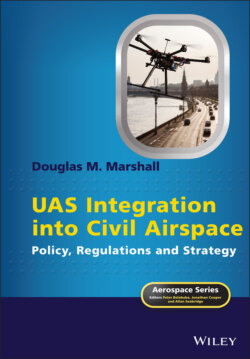Читать книгу UAS Integration into Civil Airspace - Douglas M. Marshall - Страница 8
Aerospace Series Preface
ОглавлениеThe field of aerospace is multidisciplinary, covering a large variety of products, disciplines and domains, not merely in design and engineering but in many related supporting activities. The interaction of these diverse components enables the aerospace industry to develop innovative and technologically advanced vehicles and systems. The Aerospace Series aims to be a practical, topical, and relevant series of books aimed at people working in the aerospace industry, including engineering professionals and operators, engineers in academia, and allied professions such as commercial and legal executives. The range of topics is intended to be wide ranging, covering design and development, manufacture, operation and support of aircraft, as well as infrastructure operations and advances in research and technology.
Unmanned air vehicles are a growing and increasingly accepted part of the aerospace environment. Small UAVs equipped with appropriate sensors can carry out leisure, small industry and official roles in the visible and IR spectrum. As their use expands, unmanned air systems will inevitably become involved with, and potentially conflict with, manned vehicles – as has already been demonstrated by numerous encounters near airports. There will need to be new regulations to allow the co-existence of UAVs with GAS, rotary wing, regional and transnational operations. These new regulations could require changes to on-board navigation and proximity warning systems as well as to ATM practices and standards.
This book – UAS Integration into Civil Aerospace – explores the integration of unmanned aircraft into controlled and uncontrolled airspace. It provides a comprehensive overview of regulatory and policy efforts required to move towards full airspace integration, as well as the technology that must be developed and approved for full operation of UAV systems. It also addresses the critical questions of cybersecurity and cyber resilience as they relate to UAV airspace integration. The global ATM system depends heavily on electronic communications and interconnectivity, any interruption of which could lead to potentially catastrophic consequences.
With the rapid evolution of UAV technology, aviation regulators at international, national, and local levels have struggled to keep pace with appropriate rules and standards to ensure that UAV systems operate in shared airspace in a safe, equitable, and efficient manner. This book outlines a path forward that minimizes the safety risks while maximizing potential economic benefits for all users of the airspace. In line with the mission of the Aerospace Series, it combines elements of engineering and emerging technology with an accessible discussion of the important related legal and regulatory issues.
Peter Belobaba, Jonathan Cooper, and Allan Seabridge
